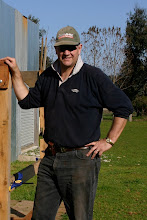After a year of steady accumulation of compostable material, it was recently time to spread the results onto my pastures.
I have previously described my compost yard and here is a view of it after a year of effort.
In this photo you can see 4 of the 6 heaps. Until shortly before this photo was taken they were each confined by 2 pieces of galvanised steel mesh - which are linked with wire and small D shackles into a circle that is about 6 metres in diameter and 1200 mm high.
Into these enclosures we pile whatever compostable material we can get. Our garden and kitchen refuse, rain damaged hay from properties in our area, dead animals, cow manure when we clean up our feed yard or the cattle trailer - anything that can create the right sort of mix or carbon and nitrogen.
Once the confining steel mesh is removed and hung on the structure to the left of the picture, I get going with my tractor. I put the bucket on the Front End Loader of my elderly John Deere tractor and scoop up about a cubic metre of compost.

I then transfer it into my Manure spreader which I tow behind behind a Polaris Ranger. It's at the limit of the Ranger's towing capacity, but I take it quietly in low ratio 4WD.
I certainly don't want to overstress the Ranger - it is an unbelievably valuable piece of equipment for multiple applications. One day I want to do a blog post on the difference between doing a job like this with a tractor, FEL and Ranger and the way it would have been done only 60 or 70 years ago when horses provided the main motive power on most farms. There is an amazing difference.
I then add a scoop of chicken manure mixed with rice hulls that I get when an organic chicken farm in Riddells Creek cleans out its sheds. It costs me $220 to have a load of about 22 m3 delivered. I feel like a 'shandy' of compost and chicken manure is quite a healthy thing to be adding to my soils.
The chicken manure was pretty dry and dusty. Son Neil needed to get out of the way or he would get a good covering.
There is a bit of a smell, but not one that I would object to. Occasionally a visitor will comment on something on the farm smelling. My every time reply is that my farm doesn't smell bad - but their City does.
Here is the Ranger with a full Manure Spreader on its way to the paddock.
The following photo shows the ground drive on the Spreader engaged and driving the apron that shifts the load backward and the metal metal beater that spreads it over about a 2 metre width.
The Spreader itself comes all the way from Ohio in the US - where it would be used to spread the stable manure resulting from housing animals indoors during a continental winter.
But it suits my purpose equally well. Over 3 days we put about 40 or 50 loads onto my most productive paddock.
As it's very dry at present we will have to wait until there is a bit of rain to see what effect it produces.
Previous spreadings in other less productive paddocks has produced a marked thickening up of the pasture sward - as much as doubling the quantity of feed available to my cattle.
And here is what my compost yard looks like before I put the mesh compost hoops back in place and start the process all over again.












No comments:
Post a Comment